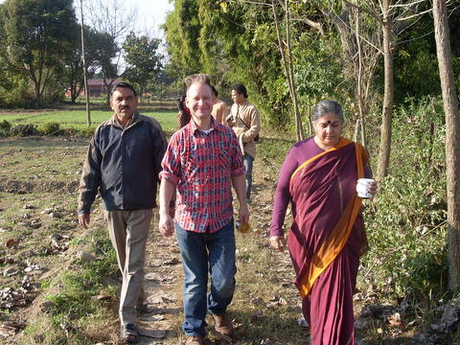
Vandana Shiva touring Navdanya Farm. Photo: Edward W. Lollis.
Vandana Shiva exposes the link between the use of genetically modified cotton seeds and the tragic suicide of 284,694 farmers in India over 17 years.
by Vandana Shiva / The Ecologist
The debate over genetically modified organisms (GMO) has greatly intensified in recent months. On one side of the debate is scientific evidence that GMOs are not delivering on their promise, and on the other side is ideological propaganda by the genetically modified seed industry and scientists whose careers are locked into the GMO trajectory.
The Technical Expert Committee (TEC) appointed by the Supreme Court of India and made up of India’s most eminent and independent scientists, has strongly recommended a ban on open field trials of genetically engineered crops until a robust, impartial regulatory mechanism has been put in place.
After two decades of commercial applications, data clearly shows that GMOs neither increase yields nor decrease the use of agrichemicals, but have instead created super-pests and super-weeds.
It is because of these failures – and the fact that GMOs are linked to patents, which translates into royalty extraction and high prices – that GMOs serve only to worsen the economic status of farmers.
India has now recorded more than 284,694 farmer suicides in that span of 17 years, between 1995 and 2012. The region most badly affected is Maharashtra – the region which has the biggest land area utilised for the cultivation of genetically modified Bt cotton.
According to P. Sainath, a journalist who has covered farmers’ suicides systematically, “The total number of farmers who have taken their own lives in Maharashtra since 1995 is closing in on 54,000. Of these, 33,752 have occurred in nine years since 2003, at an annual average of 3,750. The figure for 1995-2002 was 20,066 at an average of 2,508 a year. We also know from these records that suicides increased after Bt cotton was introduced on a large scale.
Farmers chose Bt cotton not because it was the best alternative but because all other alternatives were destroyed. The seed varieties were replaced. The Central Institute for Cotton Research has not released any public varieties since Monsanto first entered the market, and today, most Indian seed companies are locked into licensing arrangements with Monsanto.
Nor is it true that yields have increased, as was predicted. Yields of cotton in the pre-GMO period reached 1,200 kg in good years. After the introduction of Bt cotton yield has stagnated at less than half this figure (500 kg).
As the University of Canterbury research team led by Professor Jack Heinemann has also shown, North American crop production has fallen behind that of Western Europe, despite farmers in the United States using genetically modified seeds and more pesticide.
According to the researchers of University of Canterbury, the key difference between the regions is the adoption of GM seeds in North America and the use of non-GM seed in Europe. The failure to control pests has also led to an increase in pesticide use.
A study published in the Review of Agrarian Studies also showed a higher expenditure on chemical pesticides for Bt cotton than for other varieties by small farmers. Non-target pest populations in Bt cotton fields have exploded; and it is expected that this will likely counteract any decrease in pesticide use.
In China, where Bt cotton is widely planted, populations of mirid bugs – pests that previously posed only a minor problem – have increased 12-fold since 1997.
A 2008 study in the International Journal of Biotechnology found that any financial benefits of planting Bt cotton had been eroded by the increasing use of pesticides needed to combat non-target pests.
In the US – and due mainly to the widespread use of Roundup Ready seeds – the use of 4 herbicide (a group of herbicides) increased 15 % from 1994 to 2005. This is an average increase of a quarter of a pound per each acre planted with GM seed according to a 2009 report published by the Organic Centre.
Moreover, the rise of glysophate (the herbicide in Roundup) resistant weeds has made it necessary to combat these weeds by employing other, often more toxic, herbicides.
Farmers are being asked to use 2,4-D, an ingredient of Agent Orange; the toxic material that was sprayed by US troops in Vietnam. This trend is confirmed by 2010 USDA pesticide data, which shows skyrocketing glysophate use accompanied by a constant or increasing rate of use for other, more toxic, herbicides.
In Argentina, after the introduction of Roundup Ready soya in 1999, overall glysophate use more than tripled by 2005-2006.
A 2001 report found that Roundup Ready soya growers in Argentina used more than twice as much herbicide as conventional soya growers.
This is the scientific evidence. Yet, contrary to the evidence, India’s Minister of Agriculture, Sharad Pawar, stated in the Lok Sabha last August that farmers prefer genetically modified cotton as it gives higher yields, is more disease-resistant and more profitable.
This claim is false. Bt cotton has not given higher yields. It is not disease resistant. Diseases that never affected cotton, like aphids and jassids, have exploded. The bollworm, which Bt cotton was supposed to control, has become resistant and Monsanto has had to introduce Bollgard II, a higher variety of insect-resistant genetically modified cotton. All this has created debt, not profits for farmers.
If seed costs jump 8,000% and pesticide use increases 1,300%, farmers’ incomes do not increase. Pawar’s unscientific promotion of GMOs against all evidence is echoed by scientists whose careers are locked into the development of a failed technology.
Good science looks at evidence and takes feedback from the real word. Bad science shuts its mind to evidence and becomes propaganda. Sadly, in the GMO debate, those defending GMOs have only power and propaganda on their side.
Vandana Shiva is the executive director of the Navdanya Trust, India.

